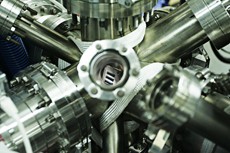The UA is on the forefront of innovative solar energy research. A $15 million grant was awarded to the university April 27 from the United Sates Department of Energy, making the UA one of the government’s new 46 Energy Frontier Research Centers.
“”It’s not every day that you get 15 million bucks in the mail,”” said Neal Armstrong, director of the research group. “”Fifteen million sounds like a lot, and we’ll spend it wisely.””
The grant was given to the UA for basic research into solar technology using organic materials. The research will be done on generation III solar cells, Armstrong said.
Armstrong said there are three generations of solar technology. Generation I is currently the most common; it is developed and well known. It is used in the solar panels on people’s roofs. These are effective, last a long time, and prices for this type of solar power are going down, he said.
“”DOE has decided, and I agree, that just that alone won’t be enough,”” Armstrong said.
Generation II solar cells are still being worked on and have not been perfected to the point of the generation I technology, but Armstrong said they are exciting because they will be less expensive, less bulky, and the panels can be flexible.
Generation III solar cells, which the UA team will be working with, are even less developed, but very exciting and innovative, Armstrong said. The solar cells are made from organic materials. He said in the last few years, the efficiency of this type of cell has been improving as scientists begin to understand the molecules better, but there is still a long way to go.
Armstrong said their research would work toward understanding and controlling molecules and molecular composition at nanometer-length scales.
“”We have a really good group of people here at Arizona,”” Armstrong said.
He said the DOE held a workshop in 2005 on solar electric technologies and in 2008 they announced the concept of Energy Frontier Research Centers. About 260 universities, research centers and non-profits around the country submitted proposals last September, with the UA being one of 46 selected.
“”It nearly killed me; it was a massive proposal,”” Armstrong said. “”It helps that we have a huge fan base in Arizona for this kind of research.””
Everything from solar power to nuclear energy is being researched by the different centers. Scott Saavedra, one of the associate directors, said the competition for the grant was pretty steep and it is an honor that the UA was chosen. It’s hard enough to get a couple thousand dollars for research, so several million is very exciting, he said.
“”This is the biggest investment in energy research in my lifetime,”” Armstrong said.
The centers will receive between $2 and $5 million per year for an initially planned five-year period.
Armstrong said with new and more affordable technologies, new energy sources are becoming a bigger deal every year as exponentially more energy is consumed in this country.
“”The good news is we have a congress, a president, and a secretary of energy who get it,”” Armstrong said.









